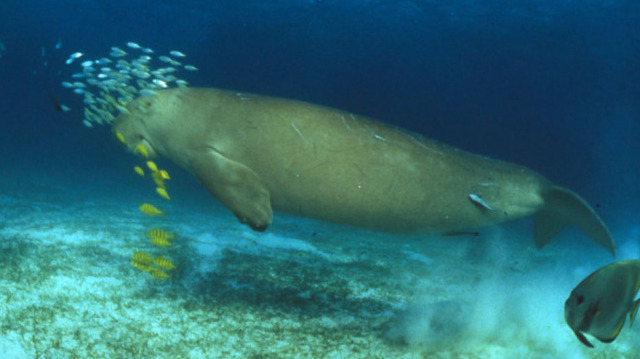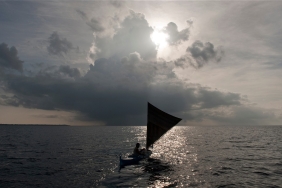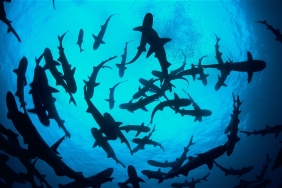EXTINCTION THREAT LOOMS FOR DUGONG
So far, some people in Alor Regency still doubt the existence of dugongs in their waters. The assumption that the dugong is an animal full of mysticism and legends is still attached. In fact, some believe that the dugong is the incarnation of humans and fish that are combined in one body.
However, according to fishermen around Kabola Village, dugongs often appear in their waters, especially on Mali Beach. This is what then prompted DAAI TV in collaboration with WWF-Indonesia to conduct documentary coverage of the population, behavior and habitat of dugongs in the waters of Mali Beach, Alor Regency.
Dugong monitoring was conducted in October 2014 in two locations, namely the waters of Mali Beach and the eastern waters of Sika Island. The selection of this monitoring location was carried out with reference to information obtained from local fishermen. According to them, there are two dugongs in the waters of Mali Beach, and five dugongs in the eastern waters of Sika Island.
The waters of Mali Beach itself are included in the protection zone in the Regional Marine Conservation Area (MPA) of Alor Regency. This 400.83 hectare area has been established by Regent Regulation Number 6/2009 concerning MPA Reserves in Alor Regency.
As a result, one dugong was found in the waters of Mali Beach. But in the waters of Sika Island, we did not find the presence of these marine mammals. The absence of dugong in the waters of Sika Island is thought to be due to bombing activities carried out by fishermen in the MPA. This has caused the dugong population to be disturbed and possibly choose safer and more protected waters.
Dugong under threat
1. Population Unknown
The size of the dugong population in Indonesian waters has yet to be ascertained due to the limited population status studies conducted. Information on the presence of dugong is generally sourced from information from fishing communities.
2. Illegal Fishing
Illegal capture of dugong by the community is still often heard until now. The lack of socialization and guidance to the community is suspected to be one of the causes of this illegal activity. Based on information from various sources, many dugong catchers still do not know that dugong is a protected biota.
3. Habitat Damage
The sustainability of dugong has a close relationship with the existence of seagrass beds, because seagrass is the main food of dugong. Damage to seagrass habitat due to human activities is allegedly one of the causes of the decline in the dugong population in Indonesia.
Poaching for consumption and trade, injury from ship propellers, and habitat degradation that results in a reduction in food availability, such as sand mining, coastal reclamation, coastal building and high sedimentation due to deforestation.
4. Bycatch
The intersection of dugong habitat and fishing grounds is difficult to avoid. In some cases, it is often reported that dugongs are entangled in gill nets used by fishermen to catch fish.
Right to Life for Protected Dugong
Based on Government Regulation No. 7/1999 concerning the Preservation of Plants and Animals, in protected aquatic biota. This is because the dugong is a marine mammal whose population continues to decline and is threatened with extinction.
Dugong reproduction rate is very low because generally dugong only gives birth to 1 offspring every 9-10 years (Skalalis, 2007). Plus when food availability is lacking, dugongs will delay the breeding season.
Although the dugong has been designated as a protected biota in Indonesia, the national dugong population is indicated to continue to decline and if no measures are taken, it is feared that the dugong could experience extinction in Indonesia (Directorate of KKJI, 2014).
WWF-Indonesia together with the Department of Marine Affairs and Fisheries and the KKPD Team of Alor Regency on April 30, 2011 managed to take a picture of a juvenile Dugong with a length of 1.5 meters in these waters. This is a very important discovery for Alor district in the management of marine areas in the future, especially in the MPA of Alor district in order to protect these rare marine mammals.
The Alor MPA is part of the Sunda Banda Seascape network which has a high conservation priority because it is home to 76% of coral species, more than 3,000 fish species, and several endangered species such as sea turtles, cetaceans (whale/dolphin groups), sharks, and dugongs.
See Save the Dugong video:Conservation efforts for the dwindling number of Dugong in Alor District, East Nusa Tenggara.
Author: Tutus Wijanarko - Community Right Based Management Officer
References:
Azkab, M.H. 1998. Duyung as seagrass eater. Oseana Volume XXIII, Number 3 & 4, 1998: 35 - 39. P3O-LIPI, Jakarta.
Directorate of KKJI, 2014. Guidelines for the Strategic Plan for the Conservation of Protected and Endangered Fish Species 2015-2019. Jakarta.
Skalalis, Diana, 2007. Paper: Dugong (Dugong dugon Muller) Conservation Model. Padjajaran University.
Yapeka, 2014. Report: Seagrass Growth on the Coast of Bahoi Village





